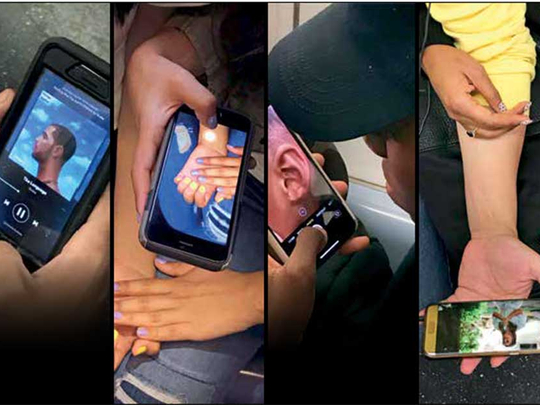
Washington: Other people’s screens are everywhere, once you start to notice them. They’re collectively most obvious at night, as they bob through the city, creating a new, hand-height layer to the ambient lights, or when held up at concerts, like lighters. During the day, other people’s screens hover around us as we wait in line for coffee, or as we sit and drink our coffee, or as we take our coffee on the bus or train.
Other people’s screens are windows into their lives, and brains, and relationships and work — into their politics, anxieties, failures and addictions. They tend to appear between one and three feet away from other people’s faces, depending.
Other people’s screens are also a lot smaller than they used to be, when they were perched almost exclusively on desks and tables at offices and in homes, where the presence of strangers is rare or worrying by default. In 2010, 27 per cent of American people carried portable screens; by the end of 2016, it was more than 80 per cent. Over the same period, the largest iPhone screen grew from 3.5 inches, from one corner to the other, to 5.5. Other people’s screens got clearer and brighter, from a wider range of angles: flat on a desk; held low, for a glance during dinner; held out for a group to see; and of course, spied over a shoulder, on the way to work.
'Shoulder surfing'
Other people’s screens have changed the phenomenon of “shoulder surfing” — peeking over shoulders, often with malicious intent — or so a team of researchers at the Ludwig Maximilian University of Munich surmised.
Shoulder surfing is why your passwords show up as dots or asterisks when you type them out on your computer or your phone. But most of the literature on it is security-focused, a response, perhaps, to questions of how best to safeguard one’s information, during a time before portable screens.
In a world in which other people’s screens are virtually impossible to ignore, there were “no detailed investigations of shoulder surfing incidents and their real-world implications,” wrote the researchers in Munich. So they distributed a survey, asking a range of questions about a hypothetical scenario in which a fictional character named “Vic” is looking at the mobile device of another fictional character named “Cas,” and Cas remains “not aware” of it.
Vic and Cas, who, disarmingly, “could both be you or anyone else” are shown as stick figures to help participants respond to prompts like: “Do you know of a **real** situation in which this happened?” and “What exactly could Vic see on the screen (eg text, pictures, passwords/PINs, maps, videos, apps, games, etc)?”
Why do people do it?
The responses to the survey did not reveal a world of thieves and victims, exactly.
In their analysis, the researchers suggested that “shoulder surfing was mostly casual and opportunistic.” It was “most common among strangers, in public transport, during commuting times, and involved a smartphone in almost all cases,” they said. Few participants indicated malicious intent when they admitted to acting like Vic and spying on Cas. “However,” the researchers wrote, “both users and observers expressed negative feelings in the respective situation, such as embarrassment and anger or guilt and unease.”
What did subjects see, on other people’s screens? Nearly half the time the answer was text. Then pictures, then games, then — in the shoulder surfing tradition — “credentials”, or passwords, more specifically. More specifically, in order of frequency, other people’s phones revealed: instant messaging, Facebook, email and news.
What did subjects “observe,” on other people’s screens? “Relationships/third persons,” most of all, but then interests and hobbies and “plans”. Why did they look at other people’s screens? “Curiosity” and “boredom” tied for first, with nothing else coming close.
Nobody really likes the idea that other people are looking at their screens. When they imagined being observed, survey participants reported negative feelings — that they felt they had been spied on, harassed, or that they were angry — in 37 cases, with just one respondent reporting “positive feelings.” (And “amused” that someone was watching.)
Works in progress
Other people’s screens are works in progress: they are tense and short texts with no context, typed and retyped, and then, for those underground, sent at the next stop; they are extraordinarily long messages, exchanges of lengths I was not aware were possible on a phone, from which one instantly turns away in shame after spotting the word “divorce;” they are selfies getting touched up, and then discarded; they are seemingly infinite group message chains full of religious affirmations; they are work emails with a lot of talk about clients, and the client, and our client, because the train is a place of work now, just like the office, just like the home.
Other people’s screens have cameras on the back, and so sometimes other people’s screens go viral. Better yet, last year, a series of photos taken of a man who was persistently and obviously looking at other people’s screens — some who turned away, and some who didn’t — was retweeted more than 51,000 times. Screens, captured and posted on purpose, are one of the sources of the raw content that fuels the modern commercial internet, and so looking at other people’s screens may be understood not just as an invasion of privacy, but maybe also a form of theft. Better not to look at other people’s screens, anyway, lest you miss a chance to witness all the other people doing it. (On a half-hour ride, in a single crowded car: no fewer than six.)
Other people’s screens may also be a brief historical aberration. Phones now unlock by scanning their owners’ faces, and, separately, can tell if you’re smiling in a photo; it is not much of a jump that they could tell when other people are watching, too, on a train or elsewhere. More broadly, it may just seem strange, someday, according to a few conceivable futures, that other people’s screens were in their hands for a while, out in the world, instead of in front of their eyes, or attached to their brains.
For this moment, though, other people’s screens will be to us as ours are to them, which is to say everywhere, and showing us just enough to remind us that, really, we should just mind our own.












